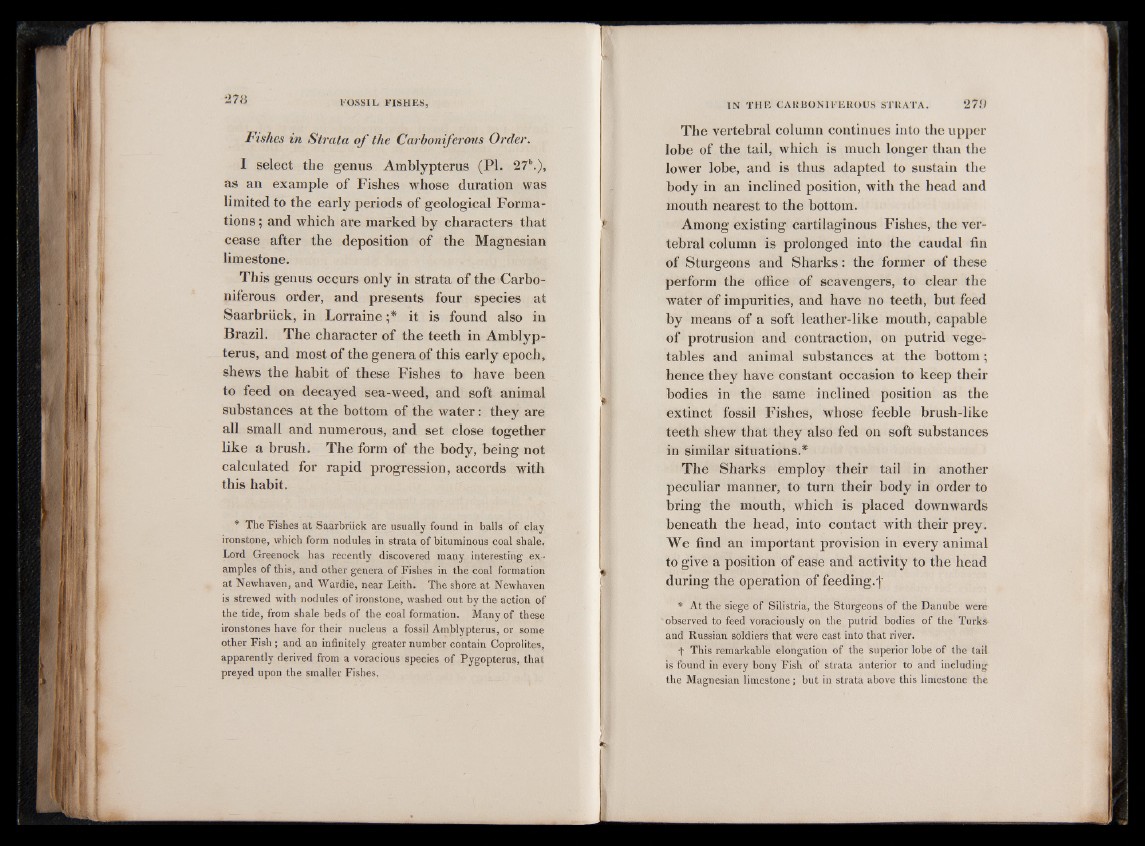
Fishes in Strata o f the Carboniferous Order.
I select the genus Amblypterus (PL 27b.),
as an example of Fishes whose duration was
limited to the early periods of geological Formations
; and which are marked by characters that
cease after the deposition of the Magnesian
limestone.
This genus occurs only in strata of the Carboniferous
order, and presents four species at
Saarbriick, in Lorraine ;* it is found also in
Brazil. The character of the teeth in Amblypterus,
and most of the genera of this early epoch,
shews the habit of these Fishes to have been
to feed on decayed sea-weed, and soft animal
substances at the bottom of the water: they are
all small and numerous, and set close together
like a brush. The form of the body, being not
calculated for rapid progression, accords with
this habit.
* The Fishes at Saarbriick are usually found in balls of clay
ironstone, which form nodules in strata of bituminous coal shale.
Lord Greenock has recently discovered many interesting examples
of this, and other genera of Fishes in the coal formation
at Newhaven, and Wardie, near Leith. The shore at Newhaven
is strewed with nodules of ironstone, washed out by the action of
the tide, from shale beds of the coal formation. Many of these
ironstones have for their nucleus a fossil Amblypterus, or some
other Fish ; and an infinitely greater number contain Coprolites,
apparently derived from a voracious species of Pygopterus, that
preyed upon the smaller Fishes.
The vertebral column continues into the upper
lobe of the tail, which is much longer than the
lower lobe, and is thus adapted to sustain the
body in an inclined position, with the head and
mouth nearest to the bottom.
Among existing cartilaginous Fishes, the vertebral
column is prolonged into the caudal fin
of Sturgeons and Sharks: the former of these
perform the office of scavengers, to clear the
water of impurities, and have no teeth, but feed
by means of a soft leather-like mouth, capable
of protrusion and contraction, on putrid vegetables
and animal substances at the bottom;
hence they have constant occasion to keep their
bodies in the same inclined position as the
extinct fossil Fishes, whose feeble brush-like
teeth shew that they also fed on soft substances
in similar situations.*
The Sharks employ their tail in another
peculiar manner, to turn their body in order to
bring the mouth, which is placed downwards
beneath the head, into contact with their prey.
We find an important provision in every animal
to give a position of ease and activity to the head
during the operation of feeding.'f'
* At the siege of Silistria, the Sturgeons of the Danube were
observed to feed voraciously on the putrid bodies of the Turks
and Russian soldiers that were cast into that river.
f This remarkable elongation of the superior lobe of the tail
is found in every bony Fish of strata anterior to and including
the Magnesian limestone; but in strata above this limestone the